A "Magic Double EMA Strategy" dos Veteranos do YouTube
Autora:FMZ~Lydia, Criado: 2022-11-07 12:02:31, Atualizado: 2023-09-15 20:51:23
A Magic Double EMA Strategy dos Veteranos do YouTube
Nesta edição, vamos discutir uma
Indicadores utilizados pela estratégia
- Indicadores da EMA
Por uma questão de simplicidade de design, nós não vamos usar o Moving Average Exponential listado no vídeo, vamos usar o built-in ta.ema da visão de negociação em vez disso (é realmente o mesmo).
- Indicadores VuManChu de balanço livre
Este é um indicador no Trading View, precisamos de ir ao Trading View e pegar o código fonte.
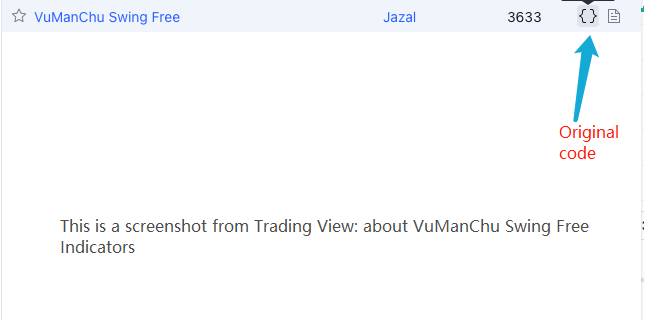
Código do VuManChu Swing Free:
// This source code is subject to the terms of the Mozilla Public License 2.0 at https://mozilla.org/MPL/2.0/
// Credits to the original Script - Range Filter DonovanWall https://www.tradingview.com/script/lut7sBgG-Range-Filter-DW/
// This version is the old version of the Range Filter with less settings to tinker with
//@version=4
study(title="Range Filter - B&S Signals", shorttitle="RF - B&S Signals", overlay=true)
//-----------------------------------------------------------------------------------------------------------------------------------------------------------------
//Functions
//-----------------------------------------------------------------------------------------------------------------------------------------------------------------
//Range Size Function
rng_size(x, qty, n)=>
// AC = Cond_EMA(abs(x - x[1]), 1, n)
wper = (n*2) - 1
avrng = ema(abs(x - x[1]), n)
AC = ema(avrng, wper)*qty
rng_size = AC
//Range Filter Function
rng_filt(x, rng_, n)=>
r = rng_
var rfilt = array.new_float(2, x)
array.set(rfilt, 1, array.get(rfilt, 0))
if x - r > array.get(rfilt, 1)
array.set(rfilt, 0, x - r)
if x + r < array.get(rfilt, 1)
array.set(rfilt, 0, x + r)
rng_filt1 = array.get(rfilt, 0)
hi_band = rng_filt1 + r
lo_band = rng_filt1 - r
rng_filt = rng_filt1
[hi_band, lo_band, rng_filt]
//-----------------------------------------------------------------------------------------------------------------------------------------------------------------
//Inputs
//-----------------------------------------------------------------------------------------------------------------------------------------------------------------
//Range Source
rng_src = input(defval=close, type=input.source, title="Swing Source")
//Range Period
rng_per = input(defval=20, minval=1, title="Swing Period")
//Range Size Inputs
rng_qty = input(defval=3.5, minval=0.0000001, title="Swing Multiplier")
//Bar Colors
use_barcolor = input(defval=false, type=input.bool, title="Bar Colors On/Off")
//-----------------------------------------------------------------------------------------------------------------------------------------------------------------
//Definitions
//-----------------------------------------------------------------------------------------------------------------------------------------------------------------
//Range Filter Values
[h_band, l_band, filt] = rng_filt(rng_src, rng_size(rng_src, rng_qty, rng_per), rng_per)
//Direction Conditions
var fdir = 0.0
fdir := filt > filt[1] ? 1 : filt < filt[1] ? -1 : fdir
upward = fdir==1 ? 1 : 0
downward = fdir==-1 ? 1 : 0
//Trading Condition
longCond = rng_src > filt and rng_src > rng_src[1] and upward > 0 or rng_src > filt and rng_src < rng_src[1] and upward > 0
shortCond = rng_src < filt and rng_src < rng_src[1] and downward > 0 or rng_src < filt and rng_src > rng_src[1] and downward > 0
CondIni = 0
CondIni := longCond ? 1 : shortCond ? -1 : CondIni[1]
longCondition = longCond and CondIni[1] == -1
shortCondition = shortCond and CondIni[1] == 1
//Colors
filt_color = upward ? #05ff9b : downward ? #ff0583 : #cccccc
bar_color = upward and (rng_src > filt) ? (rng_src > rng_src[1] ? #05ff9b : #00b36b) :
downward and (rng_src < filt) ? (rng_src < rng_src[1] ? #ff0583 : #b8005d) : #cccccc
//-----------------------------------------------------------------------------------------------------------------------------------------------------------------
//Outputs
//-----------------------------------------------------------------------------------------------------------------------------------------------------------------
//Filter Plot
filt_plot = plot(filt, color=filt_color, transp=67, linewidth=3, title="Filter")
//Band Plots
h_band_plot = plot(h_band, color=color.new(#05ff9b, 100), title="High Band")
l_band_plot = plot(l_band, color=color.new(#ff0583, 100), title="Low Band")
//Band Fills
fill(h_band_plot, filt_plot, color=color.new(#00b36b, 92), title="High Band Fill")
fill(l_band_plot, filt_plot, color=color.new(#b8005d, 92), title="Low Band Fill")
//Bar Color
barcolor(use_barcolor ? bar_color : na)
//Plot Buy and Sell Labels
plotshape(longCondition, title = "Buy Signal", text ="BUY", textcolor = color.white, style=shape.labelup, size = size.normal, location=location.belowbar, color = color.new(color.green, 0))
plotshape(shortCondition, title = "Sell Signal", text ="SELL", textcolor = color.white, style=shape.labeldown, size = size.normal, location=location.abovebar, color = color.new(color.red, 0))
//Alerts
alertcondition(longCondition, title="Buy Alert", message = "BUY")
alertcondition(shortCondition, title="Sell Alert", message = "SELL")
Estratégia lógica
Indicador EMA: a estratégia utiliza duas EMAs, uma é a linha rápida (parâmetro de período pequeno) e a outra é a linha lenta (parâmetro de período grande).
-
acordo de posição longa A linha rápida está acima da linha lenta.
-
acordo de posição curta A linha rápida está abaixo da linha lenta.
Indicador livre de fluxo de VuManChu: O indicador livre de fluxo de VuManChu é usado para enviar sinais e julgar se deve colocar uma ordem em combinação com outras condições.
Agora vamos falar sobre as condições específicas de gatilho do sinal de negociação:
-
Regras de entrada em posição longa: O preço de fechamento da linha K positiva deve estar acima da linha rápida da EMA, as duas EMA devem ser uma posição longa (linha rápida acima da linha lenta) e o indicador VuManChu Swing Free deve mostrar um sinal de compra (longCondition é verdadeiro).
-
Regras de entrada na posição curta (ao contrário da posição longa): O preço de fechamento da linha K negativa deve estar abaixo da linha rápida da EMA, as duas EMA devem ser uma posição curta (linha rápida abaixo da linha lenta) e o indicador VuManChu Swing Free deve mostrar um sinal de venda (shortCondition é verdade).
A lógica de negociação é muito simples? uma vez que o vídeo de origem não especifica o stop de lucro e stop de perda, eu vou usar um método moderado de stop de lucro e stop de perda livremente, usando pontos fixos para parar a perda, e rastreando o stop de lucro.
Projeto do código
O código do indicador VuManChu Swing Free, colocamo-lo no nosso código de estratégia diretamente sem qualquer alteração.
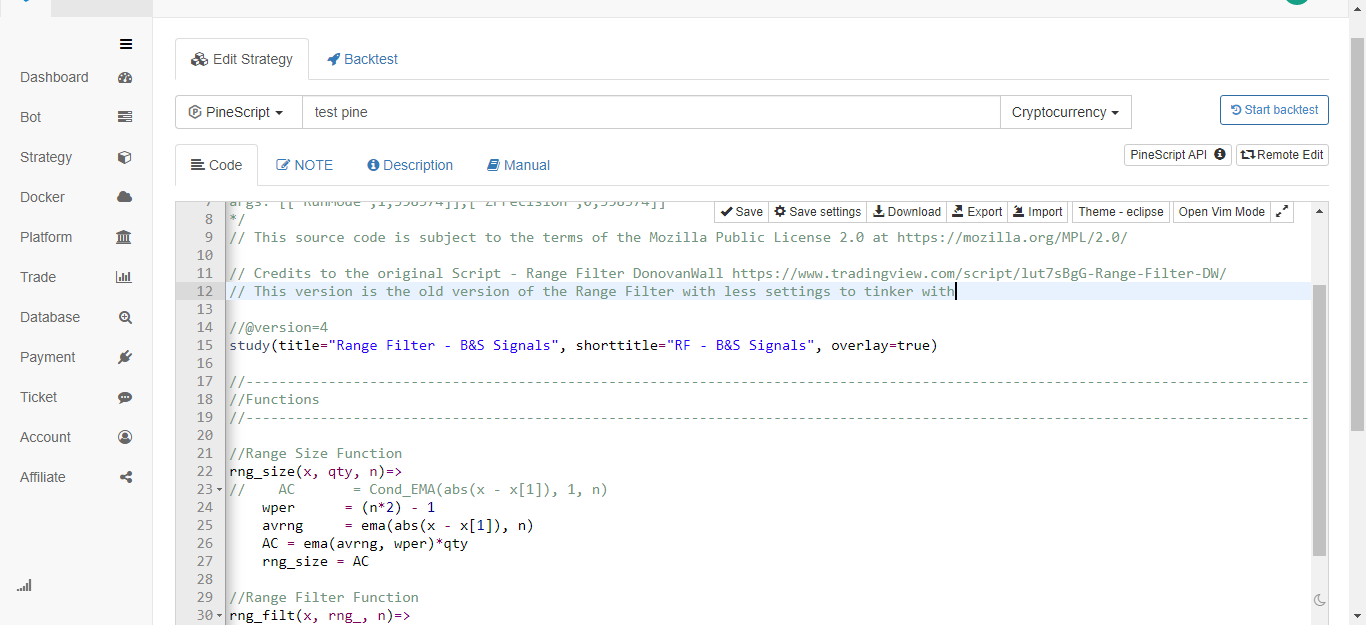
Então, imediatamente depois, escrevemos um pedaço de código da linguagem Pine que implementa a função de negociação:
// extend
fastEmaPeriod = input(50, "fastEmaPeriod") // fast line period
slowEmaPeriod = input(200, "slowEmaPeriod") // slow line period
loss = input(30, "loss") // stop loss points
trailPoints = input(30, "trailPoints") // number of trigger points for moving stop loss
trailOffset = input(30, "trailOffset") // moving stop profit offset (points)
amount = input(1, "amount") // order amount
emaFast = ta.ema(close, fastEmaPeriod) // calculate the fast line EMA
emaSlow = ta.ema(close, slowEmaPeriod) // calculate the slow line EMA
buyCondition = longCondition and emaFast > emaSlow and close > open and close > emaFast // entry conditions for long positions
sellCondition = shortCondition and emaFast < emaSlow and close < open and close < emaFast // entry conditions for short positions
if buyCondition and strategy.position_size == 0
strategy.entry("long", strategy.long, amount)
strategy.exit("exit_long", "long", amount, loss=loss, trail_points=trailPoints, trail_offset=trailOffset)
if sellCondition and strategy.position_size == 0
strategy.entry("short", strategy.short, amount)
strategy.exit("exit_short", "short", amount, loss=loss, trail_points=trailPoints, trail_offset=trailOffset)
A.Itpode ser visto que quando buyCondition é verdade, isto é:
- Variavel longCondition true (O indicador VuManChu Swing Free envia um sinal de posição longa).
- EmaFast > emaSlow (alinhamento da posição longa da EMA).
- fechar > abrir (significa que o BAR actual é positivo), fechar > emaFast (significa que o preço de fechamento está acima da linha rápida da EMA).
As três condições para continuar.
B.Quando a condição de venda for verdadeira, as três condições para fazer uma posição curta são válidas (não repetidas aqui).
Em seguida, usamos a função strategy.entry para entrar e abrir uma posição no caso de um se condição sinal de julgamento gatilho, e definir ostrategy.exitFunção para parar perdas e rastrear lucros ao mesmo tempo.
Código completo
/*backtest
start: 2022-01-01 00:00:00
end: 2022-10-08 00:00:00
period: 15m
basePeriod: 5m
exchanges: [{"eid":"Futures_Binance","currency":"ETH_USDT"}]
args: [["ZPrecision",0,358374]]
*/
// This source code is subject to the terms of the Mozilla Public License 2.0 at https://mozilla.org/MPL/2.0/
// Credits to the original Script - Range Filter DonovanWall https://www.tradingview.com/script/lut7sBgG-Range-Filter-DW/
// This version is the old version of the Range Filter with less settings to tinker with
//@version=4
study(title="Range Filter - B&S Signals", shorttitle="RF - B&S Signals", overlay=true)
//-----------------------------------------------------------------------------------------------------------------------------------------------------------------
//Functions
//-----------------------------------------------------------------------------------------------------------------------------------------------------------------
//Range Size Function
rng_size(x, qty, n)=>
// AC = Cond_EMA(abs(x - x[1]), 1, n)
wper = (n*2) - 1
avrng = ema(abs(x - x[1]), n)
AC = ema(avrng, wper)*qty
rng_size = AC
//Range Filter Function
rng_filt(x, rng_, n)=>
r = rng_
var rfilt = array.new_float(2, x)
array.set(rfilt, 1, array.get(rfilt, 0))
if x - r > array.get(rfilt, 1)
array.set(rfilt, 0, x - r)
if x + r < array.get(rfilt, 1)
array.set(rfilt, 0, x + r)
rng_filt1 = array.get(rfilt, 0)
hi_band = rng_filt1 + r
lo_band = rng_filt1 - r
rng_filt = rng_filt1
[hi_band, lo_band, rng_filt]
//-----------------------------------------------------------------------------------------------------------------------------------------------------------------
//Inputs
//-----------------------------------------------------------------------------------------------------------------------------------------------------------------
//Range Source
rng_src = input(defval=close, type=input.source, title="Swing Source")
//Range Period
rng_per = input(defval=20, minval=1, title="Swing Period")
//Range Size Inputs
rng_qty = input(defval=3.5, minval=0.0000001, title="Swing Multiplier")
//Bar Colors
use_barcolor = input(defval=false, type=input.bool, title="Bar Colors On/Off")
//-----------------------------------------------------------------------------------------------------------------------------------------------------------------
//Definitions
//-----------------------------------------------------------------------------------------------------------------------------------------------------------------
//Range Filter Values
[h_band, l_band, filt] = rng_filt(rng_src, rng_size(rng_src, rng_qty, rng_per), rng_per)
//Direction Conditions
var fdir = 0.0
fdir := filt > filt[1] ? 1 : filt < filt[1] ? -1 : fdir
upward = fdir==1 ? 1 : 0
downward = fdir==-1 ? 1 : 0
//Trading Condition
longCond = rng_src > filt and rng_src > rng_src[1] and upward > 0 or rng_src > filt and rng_src < rng_src[1] and upward > 0
shortCond = rng_src < filt and rng_src < rng_src[1] and downward > 0 or rng_src < filt and rng_src > rng_src[1] and downward > 0
CondIni = 0
CondIni := longCond ? 1 : shortCond ? -1 : CondIni[1]
longCondition = longCond and CondIni[1] == -1
shortCondition = shortCond and CondIni[1] == 1
//Colors
filt_color = upward ? #05ff9b : downward ? #ff0583 : #cccccc
bar_color = upward and (rng_src > filt) ? (rng_src > rng_src[1] ? #05ff9b : #00b36b) :
downward and (rng_src < filt) ? (rng_src < rng_src[1] ? #ff0583 : #b8005d) : #cccccc
//-----------------------------------------------------------------------------------------------------------------------------------------------------------------
//Outputs
//-----------------------------------------------------------------------------------------------------------------------------------------------------------------
//Filter Plot
filt_plot = plot(filt, color=filt_color, transp=67, linewidth=3, title="Filter")
//Band Plots
h_band_plot = plot(h_band, color=color.new(#05ff9b, 100), title="High Band")
l_band_plot = plot(l_band, color=color.new(#ff0583, 100), title="Low Band")
//Band Fills
fill(h_band_plot, filt_plot, color=color.new(#00b36b, 92), title="High Band Fill")
fill(l_band_plot, filt_plot, color=color.new(#b8005d, 92), title="Low Band Fill")
//Bar Color
barcolor(use_barcolor ? bar_color : na)
//Plot Buy and Sell Labels
plotshape(longCondition, title = "Buy Signal", text ="BUY", textcolor = color.white, style=shape.labelup, size = size.normal, location=location.belowbar, color = color.new(color.green, 0))
plotshape(shortCondition, title = "Sell Signal", text ="SELL", textcolor = color.white, style=shape.labeldown, size = size.normal, location=location.abovebar, color = color.new(color.red, 0))
//Alerts
alertcondition(longCondition, title="Buy Alert", message = "BUY")
alertcondition(shortCondition, title="Sell Alert", message = "SELL")
// extend
fastEmaPeriod = input(50, "fastEmaPeriod")
slowEmaPeriod = input(200, "slowEmaPeriod")
loss = input(30, "loss")
trailPoints = input(30, "trailPoints")
trailOffset = input(30, "trailOffset")
amount = input(1, "amount")
emaFast = ta.ema(close, fastEmaPeriod)
emaSlow = ta.ema(close, slowEmaPeriod)
buyCondition = longCondition and emaFast > emaSlow and close > open and close > emaFast
sellCondition = shortCondition and emaFast < emaSlow and close < open and close < emaFast
if buyCondition and strategy.position_size == 0
strategy.entry("long", strategy.long, amount)
strategy.exit("exit_long", "long", amount, loss=loss, trail_points=trailPoints, trail_offset=trailOffset)
if sellCondition and strategy.position_size == 0
strategy.entry("short", strategy.short, amount)
strategy.exit("exit_short", "short", amount, loss=loss, trail_points=trailPoints, trail_offset=trailOffset)
Teste de retrocesso
O intervalo de tempo do backtest é de janeiro de 2022 a outubro de 2022. O período de linha K é de 15 minutos e o modelo de preço de fechamento é usado para o backtest. O mercado escolhe o contrato perpétuo Binance ETH_USDT. Os parâmetros são definidos de acordo com os 50 períodos de linha rápida e 200 períodos de linha lenta no vídeo da fonte. Outros parâmetros permanecem inalterados por padrão. Eu defino pontos de stop loss e rastreamento de stop profit para 30 pontos subjetivamente.
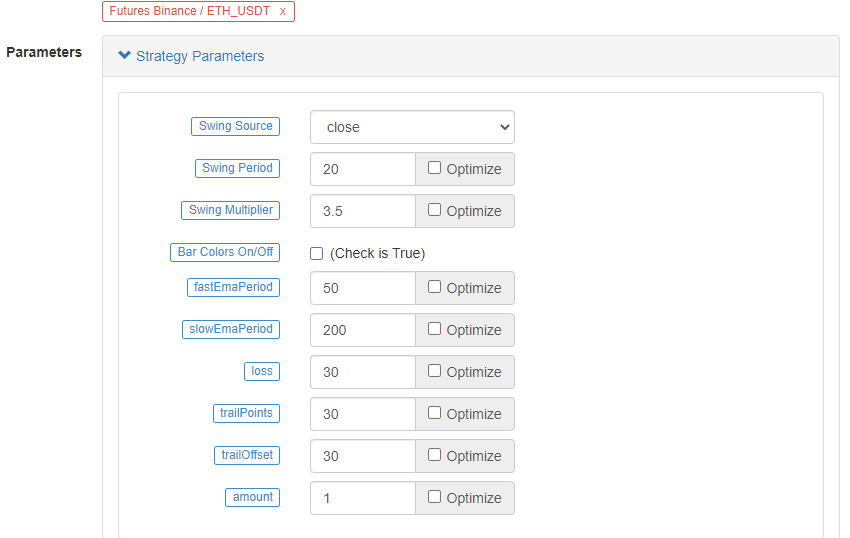
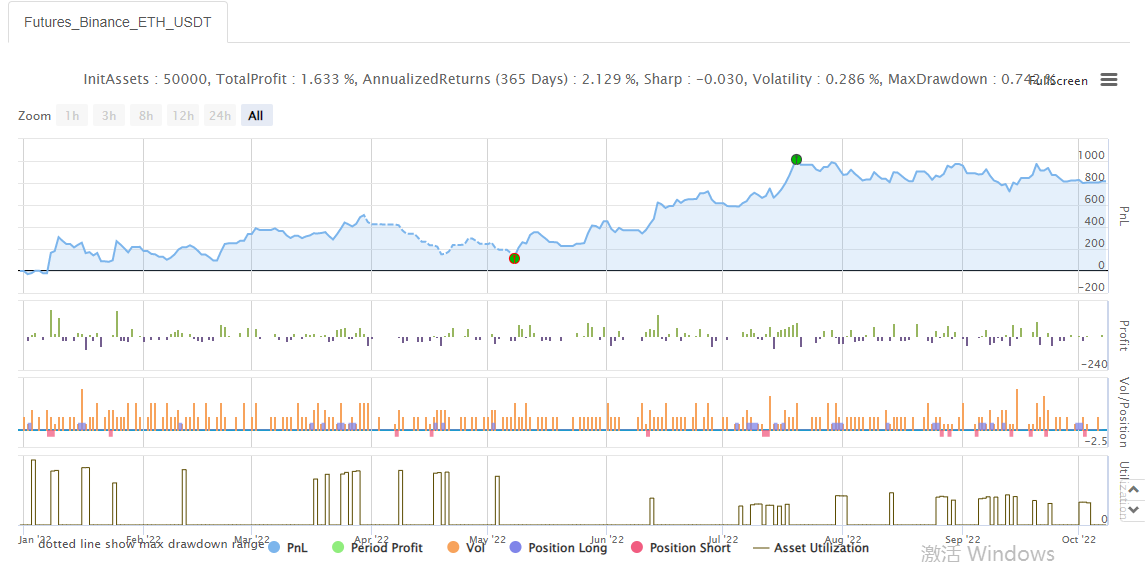
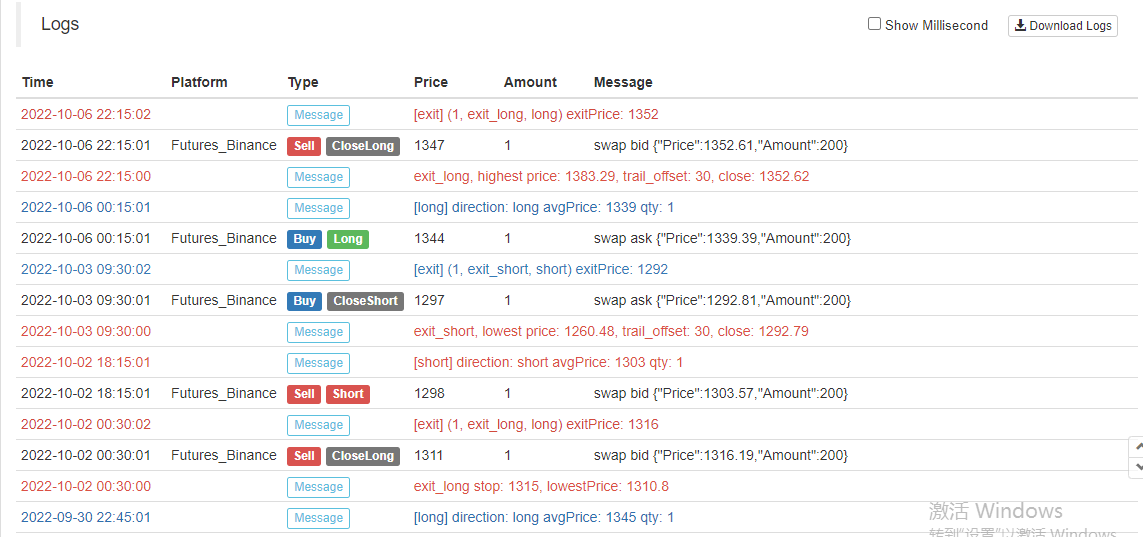
Os resultados do backtesting são comuns, e parece que os parâmetros de stop-loss têm alguma influência nos resultados do backtesting.
Vamos tentar um contrato perpétuo BTC_USDT diferente:

O resultado do backtest no BTC também foi muito lucrativo:

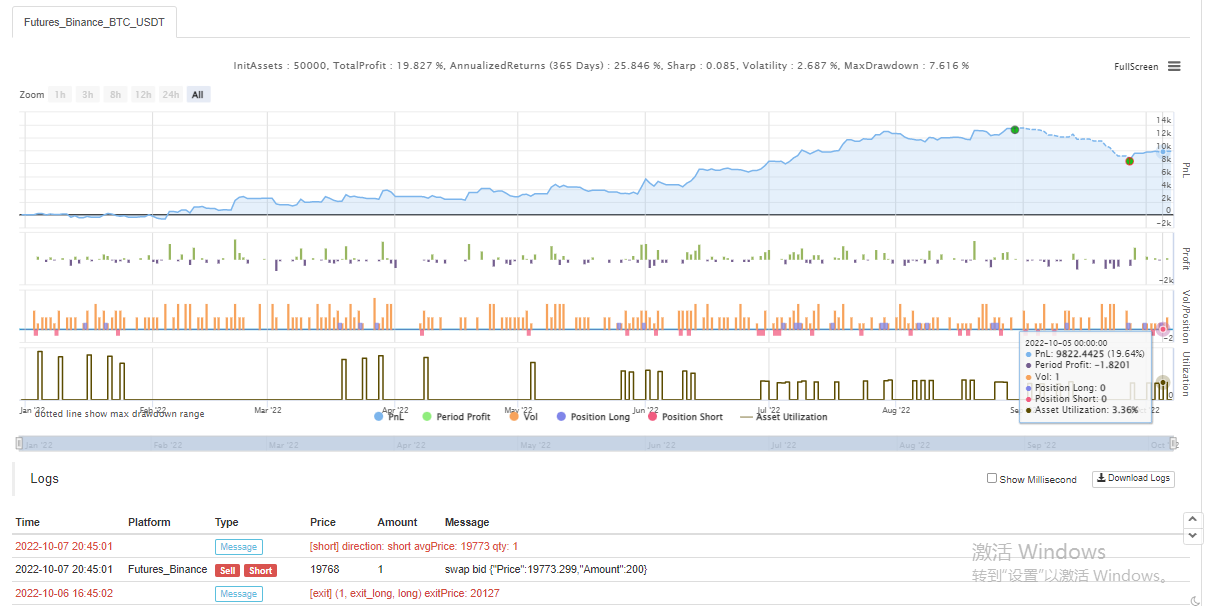
Estratégia de:https://www.fmz.com/strategy/385745
Parece que este método de negociação é relativamente confiável para entender a tendência, você pode continuar a otimizar o design de acordo com essa idéia. Neste artigo, não só aprendemos sobre a idéia de uma estratégia de média móvel dupla, mas também aprendemos como processar e aprender a estratégia dos veteranos no YouTube. OK, o código de estratégia acima é apenas meu tijolo e argamassa, os resultados do backtest não representam os resultados específicos do real-bot, o código de estratégia, o design são apenas para referência. Obrigado pelo seu apoio, veremos na próxima vez!
- Novo recurso do FMZ Quant: Use a função _Serve para criar serviços HTTP facilmente
- Inventores quantificam novas funcionalidades: criar serviços HTTP facilmente com a função _Serve
- FMZ Quant Trading Platform Guia de acesso ao protocolo personalizado
- Estratégia de aquisição e acompanhamento da taxa de financiamento da FMZ
- Estratégias de captação e monitoramento de taxas de financiamento da FMZ
- Um modelo de estratégia permite que você use o WebSocket Market sem problemas
- Um modelo de estratégia para usar o WebSocket sem problemas
- Guia de acesso ao Protocolo Geral para Inventores de Plataformas de Negociação Quantificadas
- Como construir uma estratégia de negociação multi-moeda universal rapidamente após a atualização da FMZ
- Como construir rapidamente uma estratégia de negociação multicurrency geral após a atualização do FMZ
- Negociação de DCA: Uma estratégia quantitativa amplamente utilizada